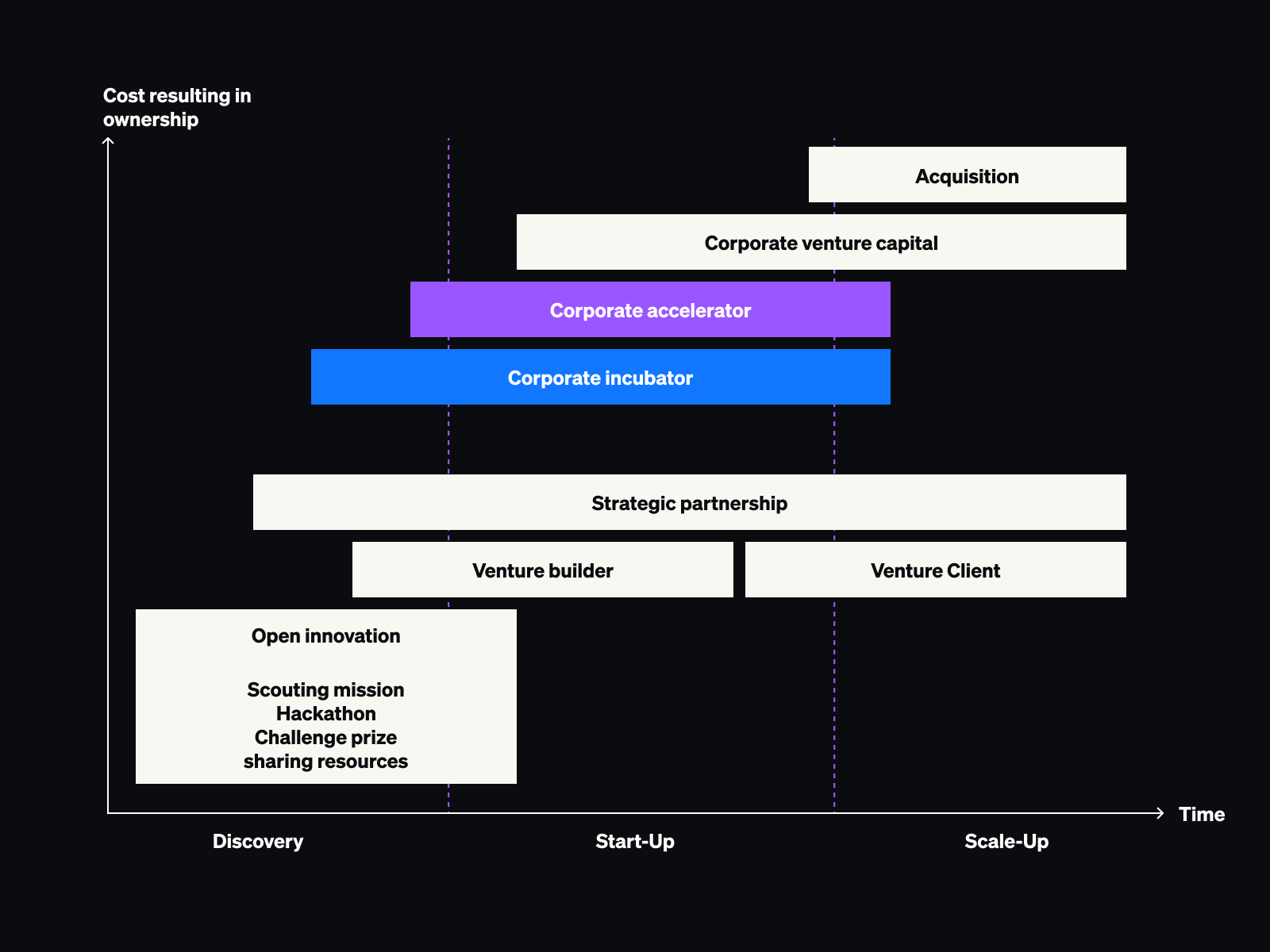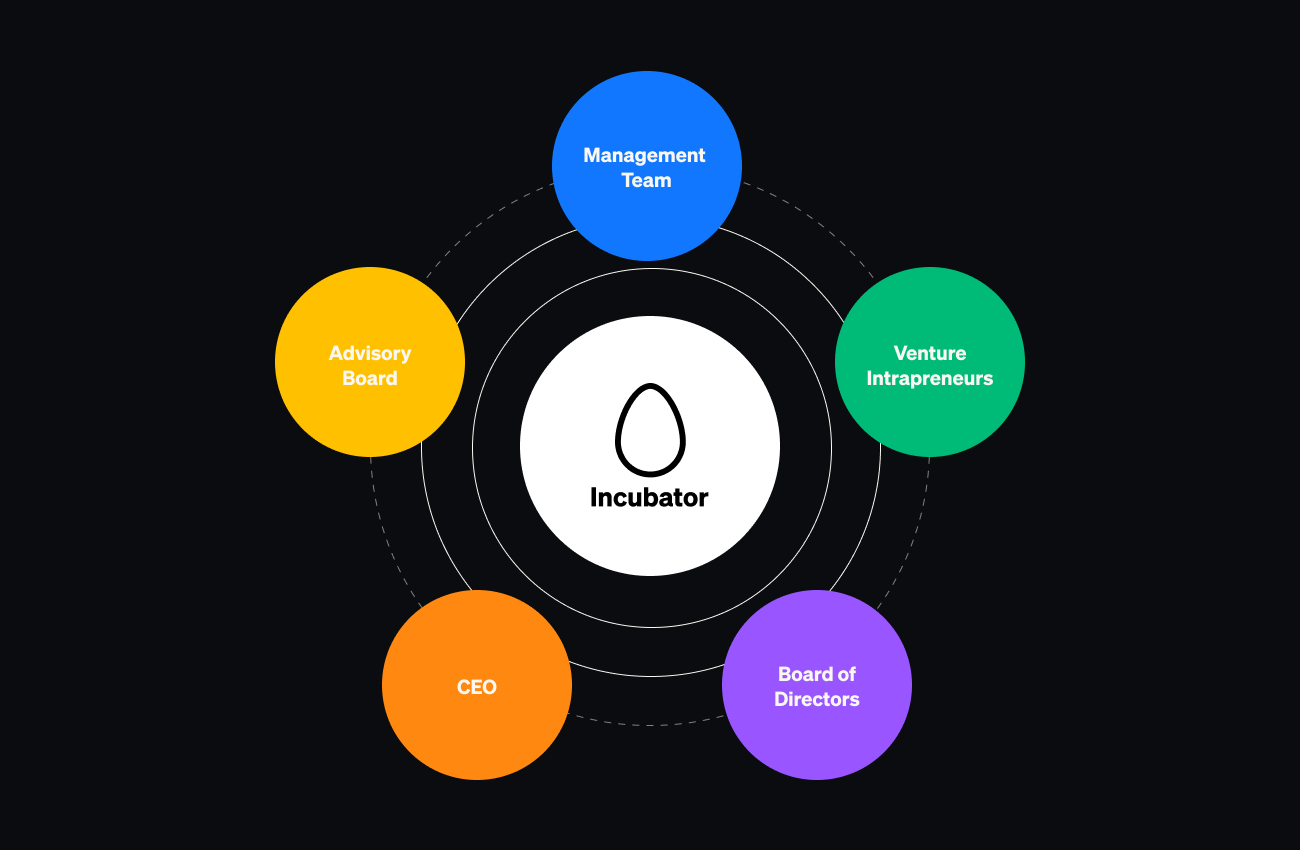Key takeaways
- Corporate incubators transform ideas into successful businesses by providing startups with resources, guidance, and strategic support within a structured company environment.
- Clear purpose and strategic alignment are critical for success. Incubators must fit the company’s long-term business objectives and innovation goals.
- The right team mix matters, whether built from internal talent, external entrepreneurs, or a hybrid model; team composition should align with the incubator’s mission.
- Positioning the incubator close to corporate leadership accelerates decision-making and ensures continued executive backing.
- Structured timelines, clear milestones, and strong resource allocation help maintain focus and momentum throughout the incubation process.
- Long-term planning beyond the incubation phase, including integration, spin-offs, or external exits, determines the true value and impact of the incubator.
What do companies like Lufthansa, Danone, and Nike have in common?
Well, aside from being leaders in their respective fields, these companies have all invested in starting their very own incubators and are currently reaping the benefits. Corporate incubators can help companies grow, operate more efficiently, and find disruptive solutions to traditional problems.
Sound intriguing? Keep reading! We’re about to walk you through the 10 key steps that will make your corporate incubator a success.
Let’s start things off with a little bit of background.
What is a corporate incubator?
Simply put, business incubators transform ideas into working companies.
It’s a give-and-take relationship in which:
- The corporation provides its early-stage business unit with the support and guidance it needs to develop into an independent business
- The incubator acts as a catalyst tool for the corporation to stimulate innovation and develop a pipeline of successful new ventures
This type of support can be crucial to the success of a new business.
What are the benefits of a corporate incubator?
We’ve already touched on some of the key benefits of starting your own corporate incubator, but here are a few, more specific examples:
- They’re a great way to actively involve your employees in the innovation process and build a culture of innovation.
- They help companies tap into new markets and stimulate the development of new value propositions.
- They encourage the exploration of new research directions and help companies commercialize their expertise and know-how.
- The newly acquired insights can help companies solve problems faster, more cost-effectively and at a lower risk.
- They foster a supportive environment that facilitates innovation by creating, experimenting and learning by failing.
- They provide access to new ideas, skill sets, and technologies
- They can expand a company’s strategic vision

Corporate incubators vs accelerators: What’s the difference?
Although some people use these terms interchangeably, the concepts are quite distinct from each other:
- Incubators “nurture” disruptive ideas with the aim of helping them transform into an independent company with a solid business model.
- Accelerators are the next step in the process, helping young companies expedite their growth and scale their existing business models.
Here are a few other key differences:
- Programming: Corporate incubator programs tend to be flexible and on-demand due to the rapidly changing needs of a young company that is still establishing itself. Accelerator programs are fixed and highly structured because scaling a business model is a comparatively more straightforward task.
- Duration: The “incubation” process lasts 1 to 3 years and concludes when the new company is ready to be pitched to investors or consumers. On the other hand, the “acceleration” process lasts only 3 to 6 months and ends when the company has reached its predetermined development and scaling goals.
- Return: Corporate incubators usually have full ownership of the venture, while accelerators tend to establish partnerships or arrange some sort of equity in the venture.
Now that we’ve covered the basics, let’s explore the 10 key steps that’ll help you take your corporate incubator to the next level!
10 Key Steps to Making your Corporate Incubator a Success.
Step 1: Establish a clear purpose
Start by envisioning what your end goal is, and why your company needs an incubator, e.g.:
- Are you trying to remain competitive in a changing market?
- Are you looking to change your company culture?
- Are you looking to create new revenue streams?
Once that’s done, work on figuring out what the scope of your incubator will be e.g.:
- What expertise will your incubator have?
- What knowledge and assets will you leverage to gain a competitive advantage?
- Does your plan include exploring new technologies?
Based on that, you’ll have a pretty good idea of what your incubator’s direction will be and the resources you’ll need to get started.
Let’s look at two examples:
RBC Ventures, a thriving subsidiary of the Royal Bank of Canada, focuses mostly on exploring new markets that go beyond traditional banking. In terms of establishing a clear purpose, they went pretty specific.
Their purpose was to get 5 million people to use the products and services of RBC Ventures within a 5-year span and then convert 10% of that client base into Royal Bank of Canada clients.
Lufthansa’s Innovation Hub is another great example. Having been set up to explore new digital business models, their main focus is to improve everyday travel through digital solutions.

Step 2: Define the range of your corporate incubator
It’s important to have a clear idea of how far you want to branch out from your core business. A good way to start is by figuring out what type of innovation you’re looking to achieve e.g.:
- Radical innovation: Disrupt the market by developing new products or services that don’t exist yet.
- Adjacent innovation: Entering a new market by leveraging your company’s existing expertise.
- Core Innovation: Optimising existing products for existing customers.
Walmart’s Nº8, for example, focuses on radical innovation to explore new markets and change the way people shop.
Capital One Labs from Capital One, on the other hand, focuses more on a mix of adjacent and core innovation, by developing products that improve the lives of their customers.

Step 3: Decide how to build your corporate incubator team
Once you have a good idea of what your new incubator’s product or service will be, the next step is to figure out the type of expertise you’ll need to make it a reality.
For example, do you have the knowledge-base you need within your corporation? If so, will your new business unit consist of only internal intrapreneurs?
Depending on what your new offering is, you might need to bring in experts from outside your company. If that’s the case, you’ll have to choose between building a new team with only external experts or a mix that includes people from within your corporation as well.
Google’s Area 120, for example, is an employees-only program aimed at encouraging small teams to build innovative products.
Coca Cola’s Founders takes a different approach by collaborating solely with external entrepreneurs to come up with new business ideas and create new ventures.

Step 4: Define the potential additional activities of your corporate incubator
Find new ways to expand your portfolio by investing in and partnering up with startups that fit within the focus of your incubator e.g.:
- Startup investment: Investing in startups within the focus of the incubator.
- Mergers & acquisitions: Take over existing startups within the focus of the incubator.
- Startup acceleration: Inviting startups to join an added acceleration program.
Lufthansa Innovation Hub is renowned for actively engaging in these types of activities to help further its digital capabilities and build a more innovative culture.

Step 5: Focus on the right criteria to select your corporate venture ideas
Focusing on the right criteria will help you make well-founded decisions when refining your venture ideas later on.
Here are just a few examples of the type of criteria you should consider:
- Problem statement
- Solution fit
- Company strategy fit
- Market Validation
- Venturing Team
- Business Case
Covering your bases early on will significantly increase your chances of success as you move through your incubator program.

Step 6: Set up a timeline and milestones for your corporate incubator program
Make sure you have detailed outlines illustrating the duration, process flows, milestones and deliverables of your incubator program.
Taking this step will help keep you focused on your goals and avoid unnecessary delays.
LEO Pharma’s Innovation Lab is a great example of how useful step 6 can be. Each of their products and services is subject to a strict 100-day build phase. Setting up such a precise timeline helps them go from idea to market quicker and more efficiently.
Phillips Healthworks operates under a similar program designed to help them move quickly between ideas and new venture concepts. They use a 3 phase system of sprints to ideate, experiment and pitch each product or service.

Step 7: Allocate your resources wisely
New ventures need resources to get up and running, and it takes a lot more than just money to make it all happen.
Make careful decisions about which resources will be allocated to strengthen your new ventures e.g.:
- Which departments will be involved (e.g. legal, engineering, I.T., marketing, etc.)?
- What type of monetary resources do you have available?
- Will you be working with any external sources of funding (e.g. crowdfunding, grants, loans, resource funding, etc.)?
- What type of office space and equipment will you be using?
- Does your incubator program need any additional services (e.g. entrepreneur or startup networks, advisory boards)?
- Do you need to set up any strategic partnerships?
Having a clear idea of what resources your incubator program needs will help you reach your scale phase quicker and more efficiently.

Step 8: Motivate your team with the right incentives
Setting up an effective incentives program is a crucial factor in the success of any new venture; so put careful thought into the type of incentive programs you’ll use.
Taking this measure early on will ensure that your team is adequately motivated to build your next breakthrough product or service.
BASF knows all about keeping a team motivated. They set up the Chemovator to offer their intrapreneurs a protected space to work on different ventures with full access to all BASF resources. This encourages passion projects, while at the same time creating new opportunities for innovation.

Step 9: Position your incubator strategically within the corporate structure
Positioning your incubator close to the executive level of your company will help you bypass long chains of command and expedite your approvals.
This can go a long way in helping you:
- Keep the support and backing of your corporation’s leadership
- Accelerate the development of your new business unit
Remember, no matter how brilliant your business ideas are, your venture runs the risk of being delayed or even phased out if you don’t have the right positioning, connections and internal support.

Step 10: Plan past the incubation phase
Decide on what happens when your venture is incubated, and ready to scale. Here are just a few factors you should consider:
Are you working towards selling your venture to an external buyer?
- What type of investment will you be making or needing in the next phase of your venture?
- Are you planning on establishing any partnerships?
- Will you become a spin-off company?
- Will your business unit be internal or external to your corporation?
Having a long term plan will keep you focused and working towards your pre-established goals, increasing the chance that your business unit will become a prosperous company when the time comes to scale.
FAQs about corporate incubators
Q. What are the key success factors for building a corporate incubator?
Successful corporate incubators require clear strategic alignment, dedicated leadership support, the right talent mix, well-defined venture selection criteria, and a structured post-incubation scaling plan.
Q. How does a corporate incubator differ from an accelerator?
Corporate incubators focus on nurturing early-stage ideas into fully formed businesses over 1–3 years, while accelerators help mature startups scale existing business models in a shorter 3–6 month timeframe.
Q. What benefits do corporate incubators offer companies?
Corporate incubators drive innovation, open new revenue streams, tap into new markets, develop internal entrepreneurial talent, and foster a more agile, innovation-driven company culture.
Q. How should companies structure their corporate incubators?
Successful incubators are often positioned close to executive leadership to streamline decision-making and typically combine internal talent with external entrepreneurs to maximise innovation potential.
Q. What are the common challenges when launching a corporate incubator?
Challenges include unclear strategic goals, lack of executive sponsorship, difficulty sourcing the right talent, misaligned venture selection, and insufficient planning for post-incubation growth.
Q. How do you measure the success of a corporate incubator?
Metrics can include the number of ventures launched, market traction achieved, revenue growth from incubated businesses, cultural transformation indicators, and the long-term impact on the portfolio.
Q. How much time and resources should a company invest in a corporate incubator?
Building a successful corporate incubator often requires a multi-year commitment, significant executive attention, cross-departmental involvement, and financial investment in both the ventures and supporting infrastructure.
Final thoughts
When executed skilfully, incubators are a great way to innovate and develop disruptive new ideas that might otherwise be scrapped in favour of everyday corporate demands.
They’re especially useful for companies that are having trouble competing due to rapidly changing technologies, an outdated business model or the arrival of newer players in the market. Find out more about how to identify the 5 key signs showing it’s time to step up your innovation game now.
If you recognise any of these traits in your company, it might be a good idea to take a closer look at investing in your own corporate incubator.
__
Building a customised incubation strategy enables you to leverage existing assets and take advantage of growth opportunities fast, all while expanding internal capabilities and fostering a culture of entrepreneurship. Get started today.
10 Key Decisions to Shape Your Corporate Incubator
Unlock actionable insights to build a high-impact incubator, from model selection to execution with precision and speed.








